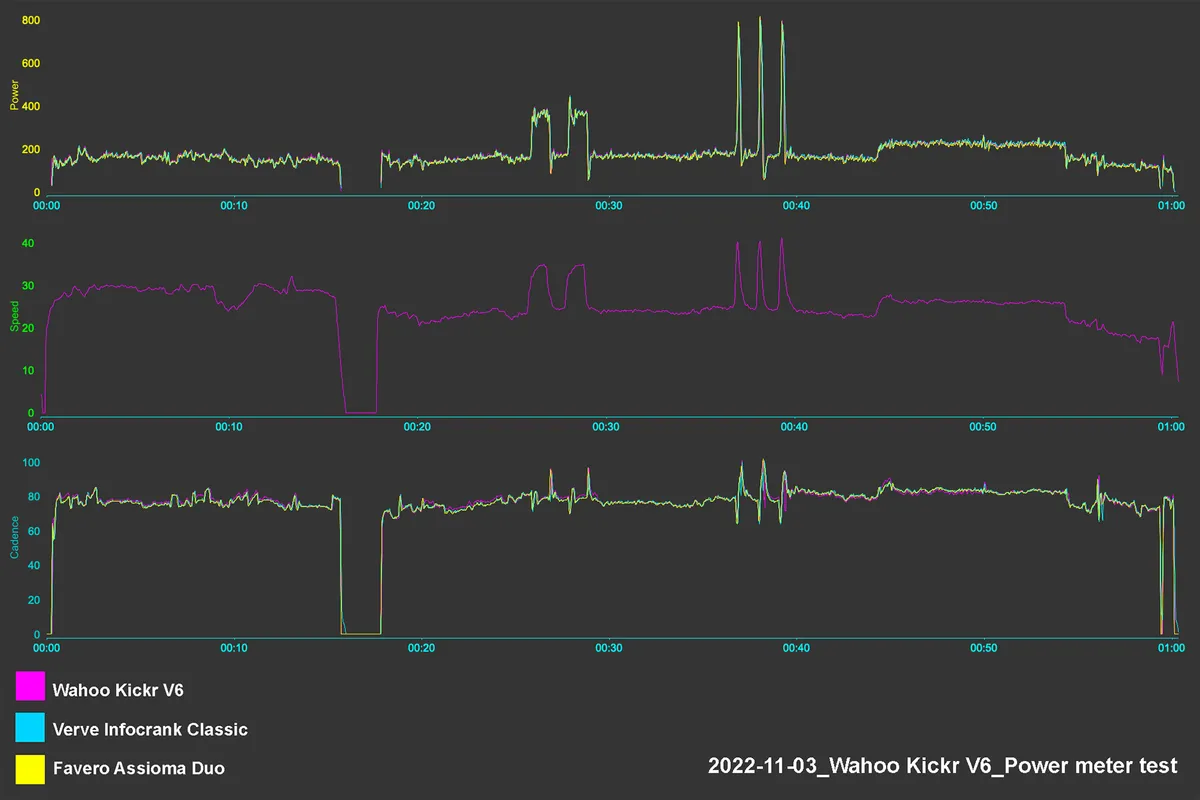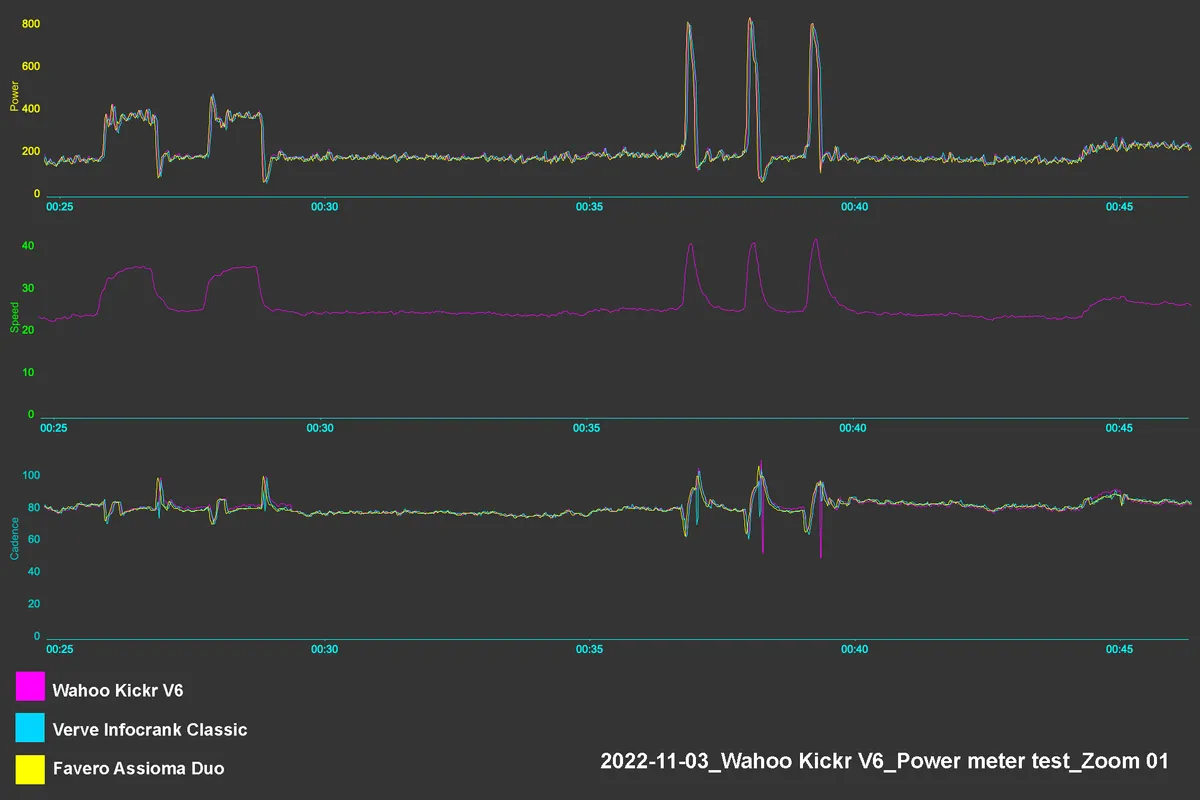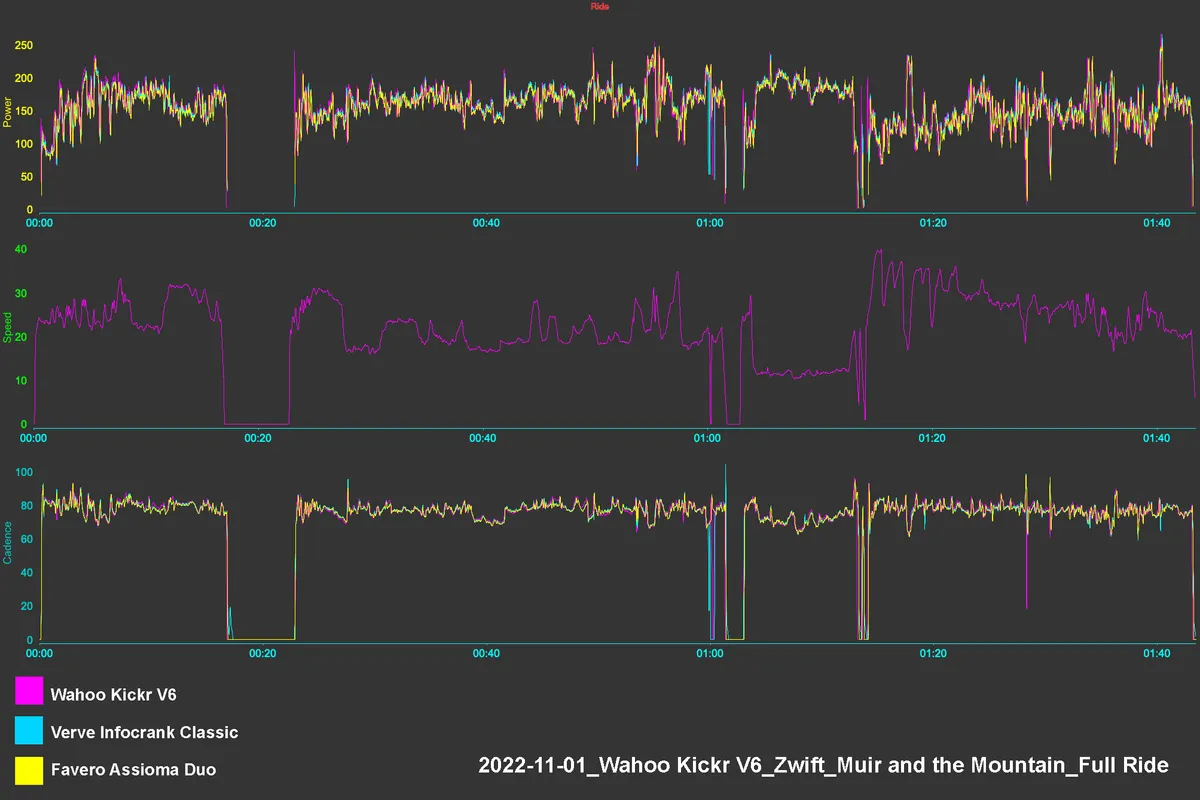The Wahoo Kickr V6 is the sixth generation of Wahoo’s high-end direct drive smart trainer.
As is almost tradition, the form factor of the Wahoo Kickr V6 is nearly identical to that of the Kickr V5 and the V4 model that came before it.
In fact, very little has outwardly changed since the original Wahoo Kickr launched in 2012.
Internally, though, the Wahoo Kickr V6 accumulates all of the various refinements to the platform that have occurred over the last decade.
The headline features added to the Kickr V6 are a 2.4 GHz WiFi connection and a small but important refinement to its ERG mode operation.
The price has also risen by £100 / $100 / €100. While similar price rises are currently reflected across much of the cycling industry, increased competition in the smart trainer market has also seen an increased availability of lower-priced options.
The Kickr V6 is one of the best-performing, best-built smart trainers available, but is that enough to warrant the extra outlay compared to cheaper competitors?
For those who require or demand the best, the Wahoo Kickr V6 should be near the top of the proverbial shortlist. For everyone else, though, the answer is less clear cut.
Wahoo Kickr V6 setup
As with previous versions, the Wahoo Kickr V6 comes fully assembled and almost ready to use. This makes setup relatively simple.
A Shimano/SRAM-compatible SunRace 11-speed, 11-28 tooth cassette comes pre-installed.
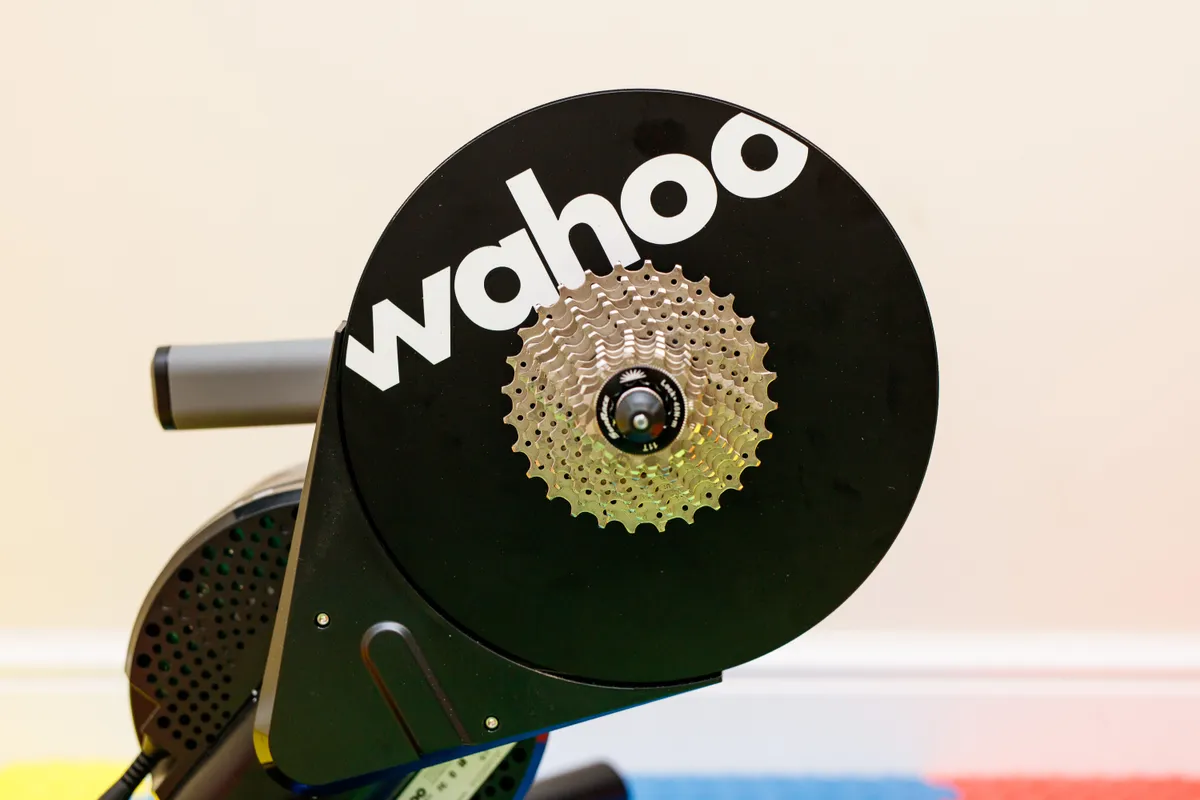
If you’re using a bike with a compatible drivetrain, 700C wheels and 135mm quick-release skewers, then you only need to adjust the flywheel support leg to the correct height, plug it in, and the Kickr V6 is good to go.
If not, you may need to change a few things, whether it’s the cassette, axle adaptors or freehub.
If your bike has a 10-, 11- or 12-speed Campagnolo or a 12-speed SRAM AXS drivetrain, then compatible freehubs are available to purchase separately from Wahoo, for £49.99 / $69.99 / €59.99 and £59.99 / $69.99 / €59.99 respectively.
Helpfully, the included thru-axle adaptors are labelled with sizes (such as 142mm or 148mm), so if you know what type of axles your bike uses, then selecting the right ones is easy.
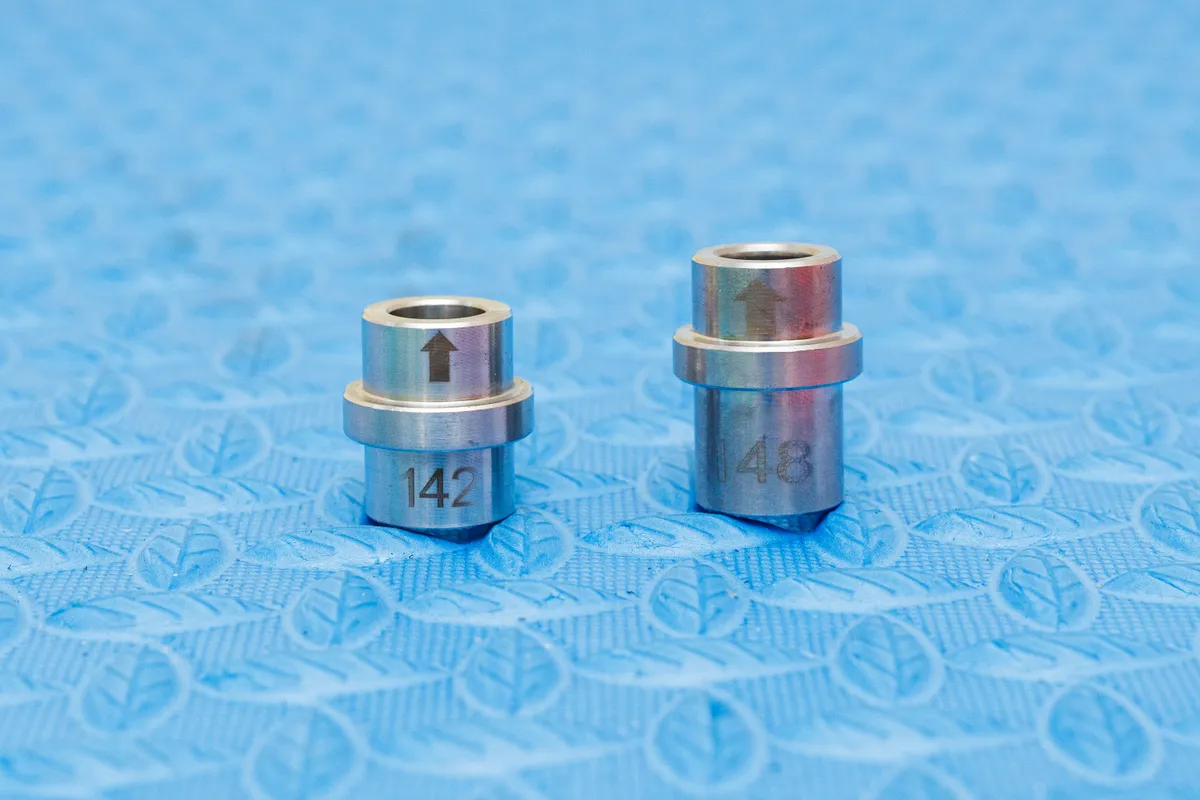
If you don’t, you may need to look it up. In that instance, our guide to road bike axle standards could prove helpful.
As with the Kickr V5, the Kickr V6 uses Wahoo’s Axis feet. These foam feet allow the Kickr to rock gently side to side, to simulate a more natural ride feel.
Different densities of foam feet are included to optimise the feel for riders of different weights, and can be swapped in and out without tools. The medium-density Axis feet are pre-installed by default, and Wahoo says they're suitable for riders weighing 63 to 81kg.
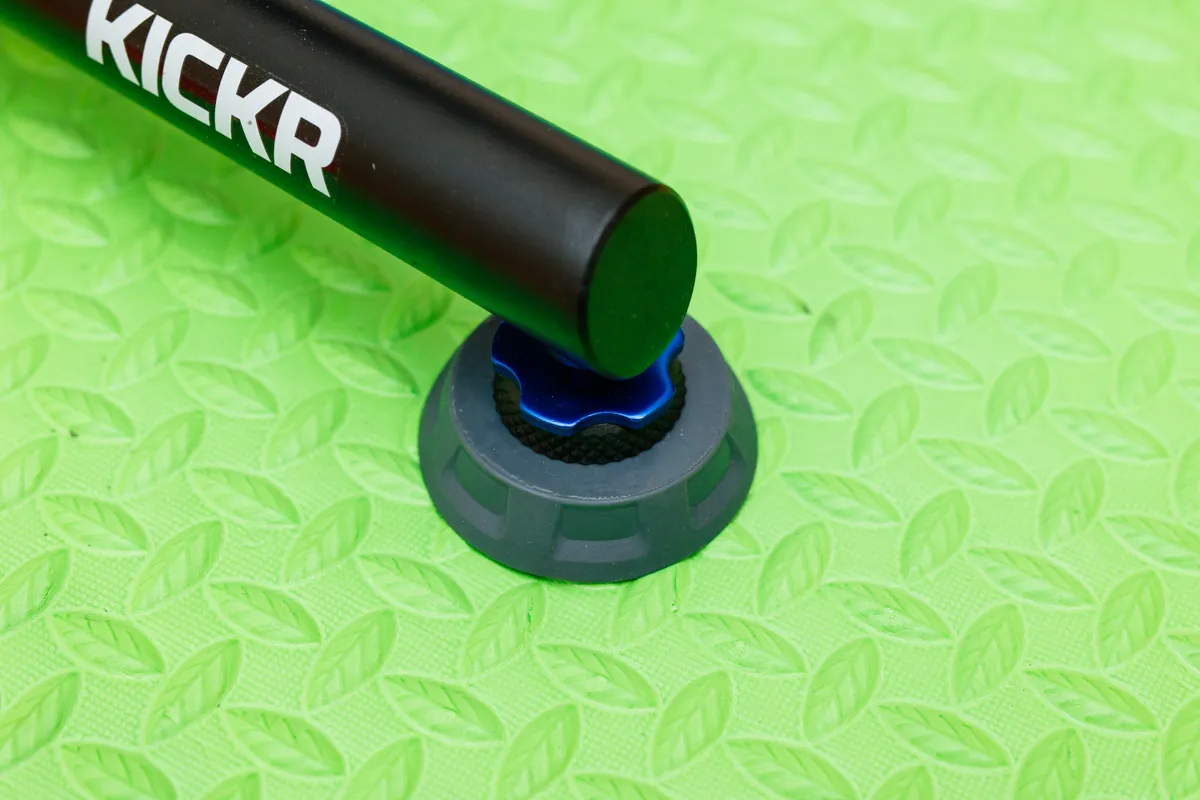
Wahoo Kickr V6 build quality
In terms of overall build quality, the Kickr V6 is very impressive. The sturdy support legs click in and out with a satisfying clunk, and the amount of metal and high-quality plastic used gives the sense of something built to last.
The folding support legs mean the Kickr V6 can be tucked in for easier storage, which is useful if you don’t have a dedicated space to leave it set up. However, its substantial mass (21.9kg) means you’re on course for a full-body workout if you’re planning to move it around a lot.
Fortunately, a well-sized integrated handle takes the guesswork out of how best to pick it up.
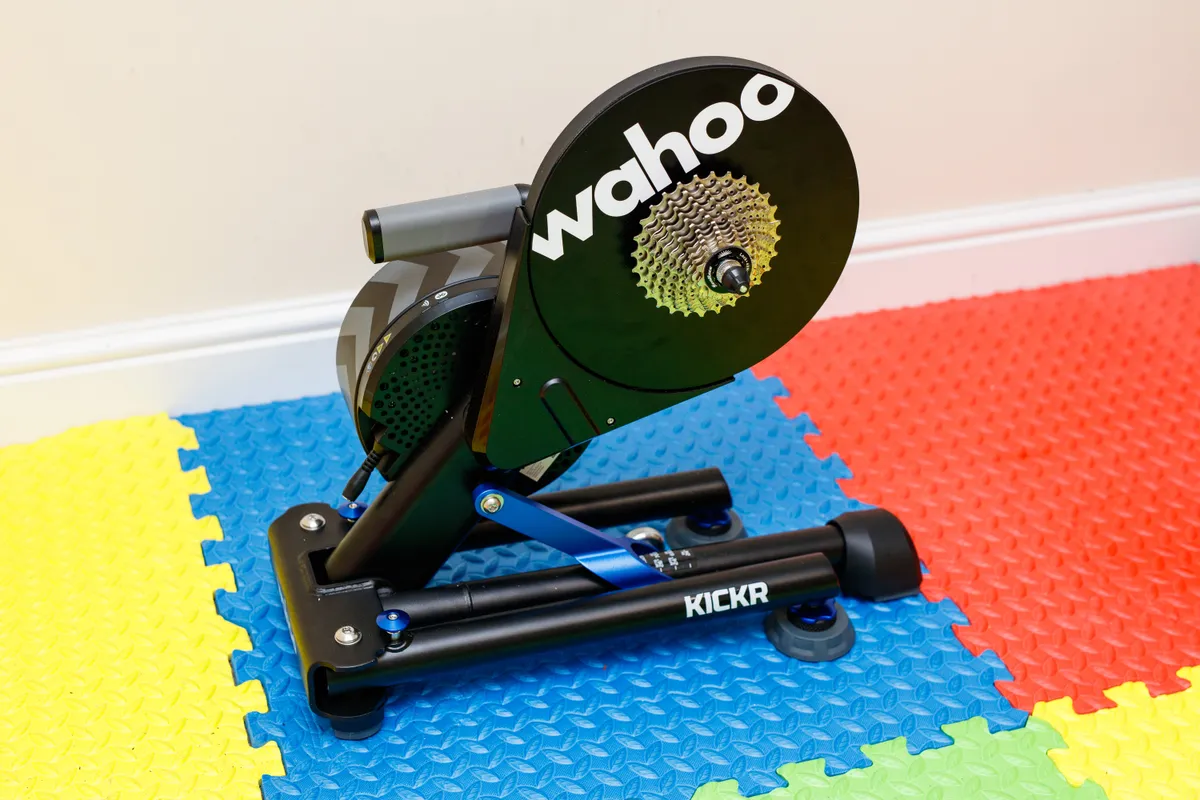
Wahoo Kickr V6 performance
Connectivity
The Wahoo Kickr V6 is compatible with ANT+, ANT+ FE-C and Bluetooth Low Energy devices, meaning you can pair it with most bike computers, cycling watches and other smart devices.
The Kickr V6 can also transmit data to up to three separate Bluetooth devices concurrently, which is convenient if you’re looking to simultaneously record your ride data on an indoor cycling app and a bike computer.
WiFi
New for this iteration is the addition of WiFi connectivity. Wahoo says this offers significantly greater data transfer speed and stability compared to Bluetooth or ANT+.
Activated via the Wahoo iOS and Android app, WiFi also enables the Kickr V6 to automatically keep its firmware up to date, negating the need to periodically check for updates.

I’ve tested many smart trainers in the past couple of years, including the previous iteration of the Wahoo Kickr. I’ve rarely had connection issues between them and my Apple devices when using Bluetooth (ANT+ is a different matter entirely, however), and that remained the case with the Kickr V6.
Given this, the addition of WiFi didn’t feel like an immediate game changer for me.
For those who have suffered poor or inconsistent connections in the past, WiFi should help smooth any bumps in the road, provided you have a reliable 2.4GHz WiFi signal wherever in your home, garage or pain cave you intend to set up the Kickr V6.
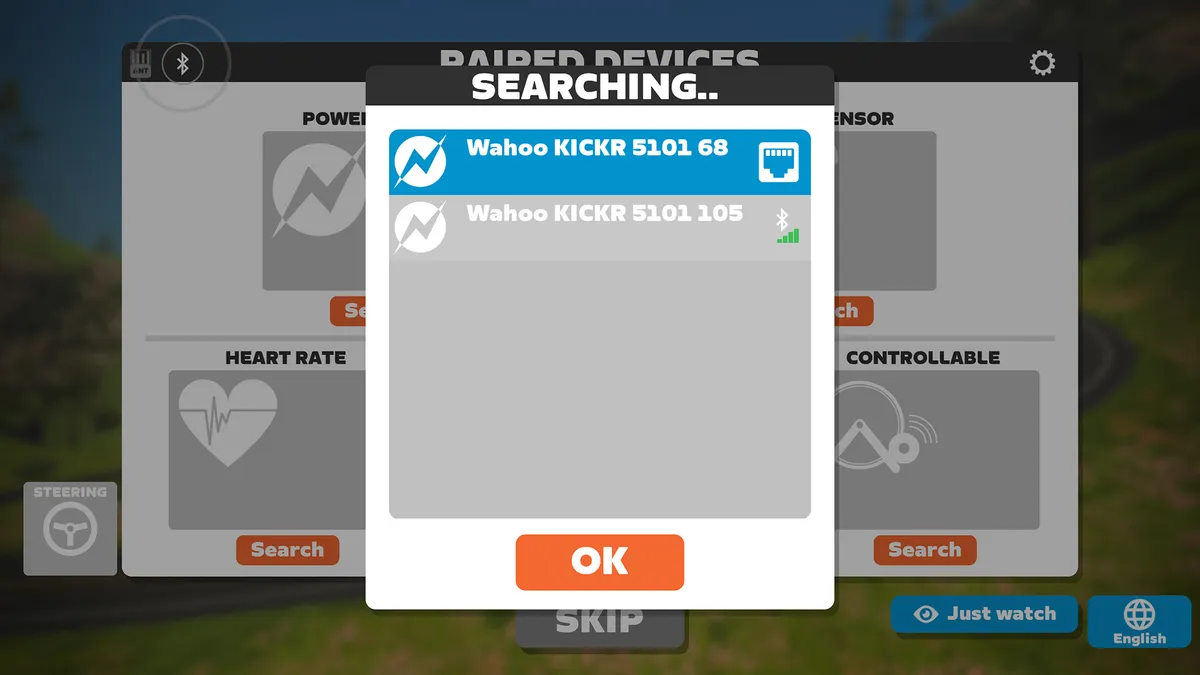
As with the Kickr V5, the Kickr V6 is also compatible with the Kickr Direct Connect dongle. This enables the use of an ethernet cable for a hard-wired connection to your local network.
As most serious gamers or esports racers will know, hard-wired internet connections typically offer the fastest, most stable performance.
Given this, it’s a shame an ethernet port wasn’t integrated into the Kickr V6, to negate the need to purchase a £79.99 dongle.
Regardless, it’s fair to say the vast majority of riders will be satisfied with one of the three available options. It wouldn’t be surprising if other smart trainer manufacturers followed Wahoo’s lead in this area.
Wahoo Kickr V6 ride feel
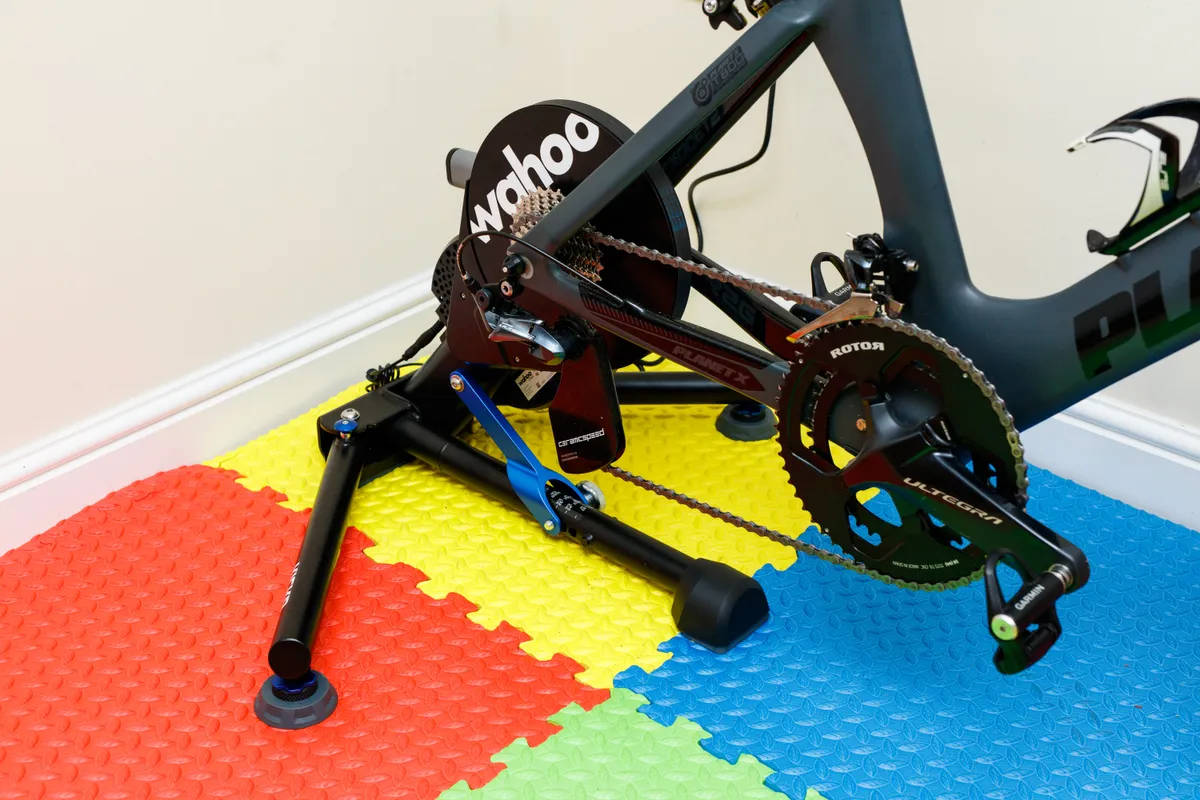
Mechanically, the Kickr V6 remains practically identical to the Kickr V5. The ride feel is also identical.
It remains up there with the very best, although it’s fair to say you should expect that at this price point.
The Kickr V6 reacts quickly and smoothly to in-game gradient changes or ERG mode power increases.
A maximum power output of 2,200 watts and maximum simulated gradient of 20 per cent also means the Kickr V6 is capable of handling everything you or your app of choice can throw at it.
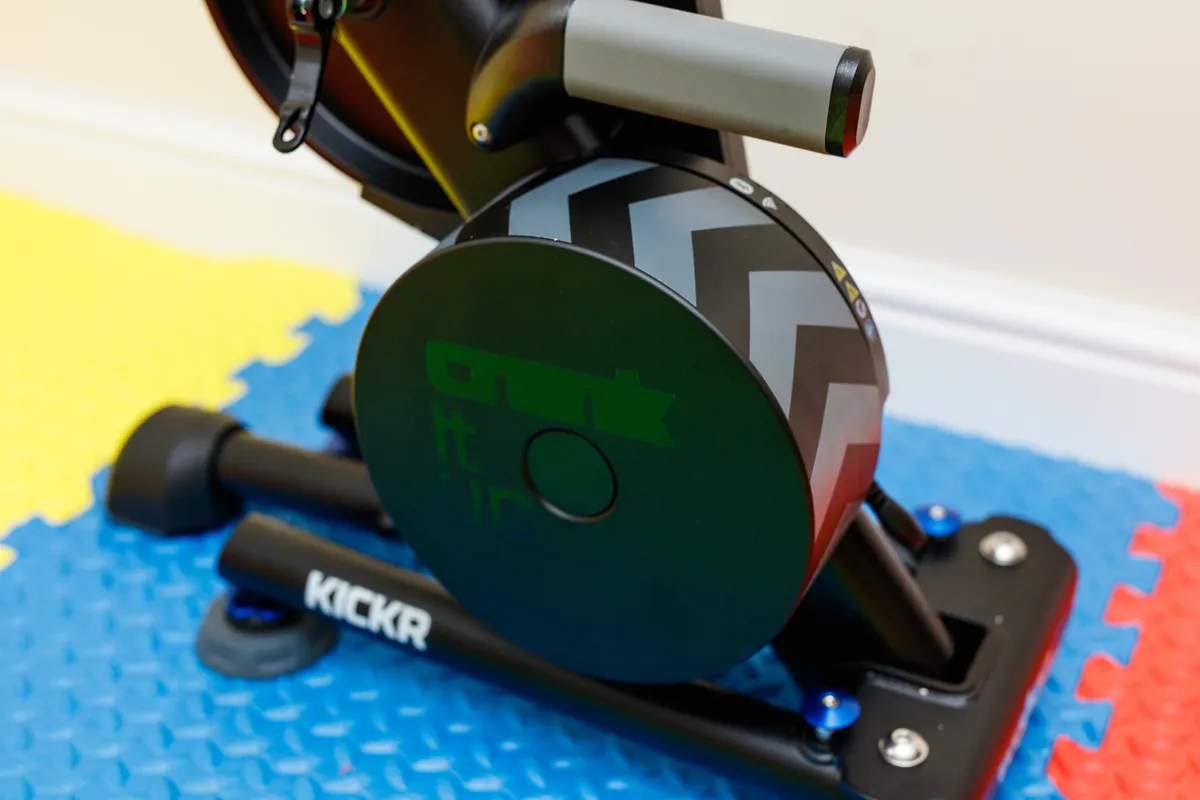
Notably, Wahoo has stuck with a traditional flywheel design (weighing a hefty 7.3kg), rather than the electromagnetic, virtual flywheel as seen on the Tacx Neo 2T (£1,199.99) and Wahoo Kickr Bike (£2,999).
This means the Kickr V6 isn’t able to simulate effects such as the acceleration felt on descents or varying road conditions, like gravel and cobblestones.
Not having these features doesn’t diminish the experience much, though, with the descent acceleration being the only one that would be a noticeable improvement (in my experience, the road surface simulations found on the Tacx Neo 2T can often feel a bit gimmicky).
If you do want a more immersive indoor cycling experience, the Kickr V6 retains compatibility with the Wahoo Kickr Climb and Kickr Headwind. Although, at £529.99 and £229.99, respectively, they’re pricey additions.

ERG Easy Ramp
New for the Kickr V6 is a feature called ERG Easy Ramp.
This helps ease the transition back into an interval, should you have to stop an ERG mode workout mid-ride for whatever reason.
Smart trainers without a feature such as this typically require you get back to the intended power level almost instantly.
If this isn’t achievable, it’s easy to fall into a so-called ‘spiral of death’ and come grinding to a halt again.
With ERG Easy Ramp, you get a full 10 seconds to come up to the right power.

This is a clear improvement to how it works, and will likely reduce the frustration involved with interrupting workouts.
Given this feature appears to be implemented entirely via software, I asked Wahoo if it would be possible to bring ERG Easy Ramp to the Kickr V5, Kickr Core and Kickr Bike V1 via a firmware update.
Happily, Wahoo said yes. It didn’t specify when this would happen, but it did say it is “working very hard to deliver this”, and that trainer owners would “be informed via updates in the Wahoo app as soon as possible.”
Wahoo Kickr V6 noise
Noise-wise, the Kickr V6 is identical to its predecessor, which (again) is no bad thing.
In use, the Kickr V6 is very quiet – the majority of the noise generated by riding comes from your bike and its drivetrain.
Putting it through my standard trainer noise test (which involves recording decibel data from a ride on an iPhone placed one metre away from the trainer, parallel to the drivetrain side of my bike), the Kickr V6 averaged around 61 decibels at 30kph, rising very slightly to just over 65 decibels at 45kph during short sprints.

As always, it’s worth noting your experience may differ compared to my measured figures, depending on what drivetrain and chain lube you’re using (in this instance I was using a waxed chain on 11-speed TA chainrings, which are typically noisier than Shimano options, for example).
Wahoo Kickr V6 power accuracy
The Wahoo Kickr V6 retains the V5’s +/- 1 per cent claimed power accuracy, and like the previous model I tested, measurements were essentially spot-on all of the time.
This remained the case even in challenging scenarios such as sustained climbing or high flywheel speeds (which often trip up cheaper smart trainers).
Running on the latest firmware, I saw no issues with power or cadence accuracy compared to benchmark power meters such as a Verve InfoCrank Classic and a set of Favero Assioma Duo pedals.
As with the Kickr V5, the Kickr V6 has an automatic calibration feature, which continually monitors speed, temperature and resistance while riding, to determine and account for the level of friction in the system. It will then automatically adjust the calibration values as required.
This essentially removes the need to perform in-app spin-down calibrations, and in my experience it works exactly as advertised.
This is useful because while performing a spin-down calibration isn’t onerous, the process is typically somewhat inconvenient because it means interrupting your ride 10 to 15 minutes in (spin-down calibrations are best performed once the trainer has had enough time to warm up). That’s not something you’d want to do in the middle of a workout or virtual group ride.
Wahoo Kickr V6 bottom line
The Wahoo Kickr V6 is easy to set up, delivers fantastic ride feel and low noise levels. It nails the data quality and has a spec sheet that can go toe-to-toe with practically every other high-end smart trainer on the market.
As with the previous-generation Kickr, the main issue remains the fact that it costs a lot (and a £100 price increase has slightly exacerbated that problem).
For most people, cheaper trainers, such as the Wahoo Kickr Core (£599.99), Zwift Hub (£449) or Elite Direto XR (£824.99), will offer more than enough performance to satisfy their indoor-cycling itch.
Ultimately, though, whether the Kickr V6 is worth almost twice the cost of trainers such as the Kickr Core will be a personal decision – it’s like deciding between a Dura-Ace or Ultegra groupset, or between a top or mid-tier carbon frame.
As with most things, the gains in performance diminish in size the further you go up in price, but the small improvements available at the high end will be valued by some.
Considerations of value aside, the Wahoo Kickr V6 is easily one of the best smart trainers available.
Product
| Brand | Wahoo |
| Price | A$1799.95, €1299.99, £1099.99, $1299.99 |
| Weight | 22g |
Features
| Mount | direct_drive |
| Folding legs | yes |
| Trainer type | smart_trainer |
| Resistance type | electromagnetic |
| Wheel size | 26in |
| Wheel size | 27_5in_650b |
| Wheel size | 29in_700c |
| Connectivity | antPlus |
| Connectivity | antPlus_fe_c |
| Connectivity | ble |
| Connectivity | bluetooth |
| Connectivity | wifi |
| Device compatibility | android |
| Device compatibility | ios |
| Device compatibility | mac |
| Device compatibility | windows |
| Noise | 61.0000 |
| Noise | DECIBEL |
| Max power | 2200.0000 |
| Max power | WATT |
| Max user weight | 113.0000 |
| Max user weight | KILOGRAM |
| Flywheel weight | 7.3000 |
| Flywheel weight | KILOGRAM |
| Max grade (degrees) | 20.0000 |
| Hub compatibility | 130/135mm quick release, 12x142mm and 12x148mm thru axle |
